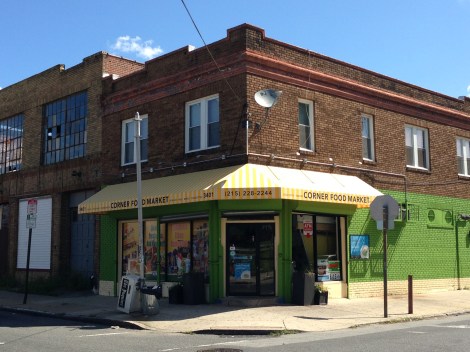Maybe it’s not surprising that Philadelphia — home of the cheesesteak, scrapple, and Tastykake — has one of the highest obesity rates among large U.S. cities. (To be fair, nobody’s bragging about their city’s quinoa salad.)
The city has been actively battling the bulge for years. Deep fryers were banned in school kitchens in 2010 and kids haven’t been able to buy soda in school vending machines since 2004, for instance. (On a related front, Philly has targeted Chinese takeout restaurants for excessive salt. No word on the fate of the fortune cookie.)
But the city’s most visible and far-reaching program, the largest of its kind in the country, has been the Healthy Corner Store Initiative. The city-wide project, spearheaded by Philadelphia-based nonprofit The Food Trust, is an attempt to convince corner stores, those one-stop shops for SunnyD and SnoBalls, to carry healthy food.

Natural Resource Defense Council/SAWYER AgencyBrianna Almaguer Sandoval.
The program began as a small pilot project, with only 11 participating stores. In 2010, it expanded to more than 600 stores of an estimated 1,500 city-wide. “We had tested in a small sample, but we didn’t know if the store owners were going to respond,” says Brianna Almaguer Sandoval, the Healthy Corner Store Initiative’s director. “But they are really stepping up. They’re reporting that they’re making money, that customers want those products.”
Besides being one of the most obese cities in the country, Philadelphia is also one of the poorest. Many advocates argue that lack of access to healthy foods in low-income areas — many of them food deserts — is a major part of the city’s obesity problem. The local corner store is the only place to buy groceries in some neighborhoods. And there’s no question that the fattening stuff they carry sells.
A 2009 study by The Food Trust and Temple University’s Center for Obesity Research and Education found that the average Philadelphia grade-school student purchased more than 350 calories on each visit to a corner store, mostly in the form of chips, candy, or sugary drinks. Nearly a third of those in the study shopped at such stores twice a day, five days a week.
In order to join the Healthy Corner Store Initiative, store owners must take a series of gradual, low-risk steps. At the most basic level, they commit to stocking and promoting four new products classified as healthy, chosen from a set menu. (Examples include fresh or frozen fruits or vegetables, whole grain pasta, and dried beans.) In exchange, they get $100. At each succeeding level, incentives like training in handling and sourcing perishable foods, in marketing, and in store layout accompany each new commitment. At the “conversion” level, incentives include equipment like shelving and refrigeration units.
Today, about half of the enrolled stores have since reached the conversion level. Sandoval, who was the initiative’s sole employee when she came on board in 2009, now heads a team of 12. And the initiative has become a model nationwide. Cities from Chicago to Washington, D.C., have launched similar programs, some with help from The Food Trust’s National Healthy Corner Store Network.
Early on, Sandoval and her team interviewed store owners about why they didn’t already stock healthy foods. The responses ranged from a lack of knowledge about how to manage perishables to lack of space to problems finding wholesale suppliers willing to sell in small quantities.
“But I would say the biggest hurdle is perception,” Sandoval says. “Corner stores in the past used to be little grocery stores. And then when supermarkets took over, the corner stores really changed to focus on packaged items. That sort of just became the status quo: This is how we operate.”

The Food Trust
Corner Food Market, a North Philadelphia store about half a mile from the nearest full-size grocery, is one of the crown jewels of the initiative. The clean, inviting market is part of a new pilot project dubbed “Fresh Corners” that takes the idea behind the initiative a step further, essentially converting bodegas into mini grocery stores. Just inside the door, a kiosk for cooking demos flanks a case filled with blueberries, avocados, tomatoes, and other produce. Colorful shopping cart logos indicate the location of healthier items like low-sodium chicken broth and vegetarian beans. One refrigerated case features a few cartons of soy milk.
Profits are up since the store joined the program, according to employee Pablo Díaz. (The owner, his brother-in-law, was out of the country when we visited.) “Before, we had this rack here with fruits and they would go bad,” he says, pointing to an unobtrusive stand at the back of the store. “Now people are buying it. Now they say, ‘You got tomatoes?’ And we say, ‘Yeah, over there.’ And they say, ‘Oh, you have everything!’”
Díaz attributes the improved sales to The Food Trust’s help with sourcing and marketing, plus changes in how produce is handled and displayed.
Some research suggests that there is no direct evidence that access to healthy food affects health outcomes like obesity. (Recent signs of improvement in the city’s obesity rate are difficult to attribute to any one factor.) But researchers at The Food Trust, Temple University, and the University of Pennsylvania are currently analyzing data from the Healthy Corner Store Initiative measuring changes in calorie consumption and body mass index in light of the increased availability of healthy snacks. Their results could help establish a clearer connection between food access and improved health.
For now, the fact that so many stores have continued to stock healthy items is a good sign that those items are selling, Salvador says. Over the last year, her team has also begun to gather precise data. Five stores now feature point-of-sale (POS) cash register systems, which track every sale. The POS data should eventually help The Food Trust determine whether stores are selling more healthy foods, as well as answer more nuanced questions about details like the effect of changing store layout or placing items on sale.
In the meantime, Sandoval and her colleagues are also working on the demand side of the equation through various education initiatives and the Snackin’ Fresh Crew, a youth group dedicated to making healthy eating hip. Among the slogans the crew has devised: “Eat Your Veggies — Have Less Wedgies.” Now there’s a powerful argument for skipping the cheesesteak.



